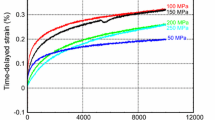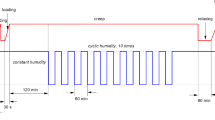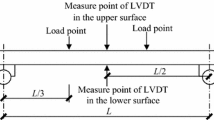Abstract
In order to investigate the way in which fibre properties affect the mechano-sorptive creep phenomenon in paper, single wood fibres were exposed to tensile stresses at a constant humidity of 80% relative humidity (RH) and in a cyclic humidity environment varying between 80 and 30% RH. Contrary to earlier claims, it was demonstrated that single wood fibres exposed to a cyclic RH show a considerably higher creep than that corresponding to the highest RH experienced in the cycle, i.e., a mechano-sorptive behaviour. The creep strain rate at cyclic humidity was shown to be a function of the creep rate at constant climate, and to be an apparent linear function of the applied stress.






Similar content being viewed by others
References
Alfthan J (2004) Micro-mechanically based modeling of mechano-sorptive creep in paper. PhD Thesis, Solid Mechanics, KTH, Stockholm
Bazant Z P (1985) Constitutive equation of wood at variable humidity and temperature. Wood Sci Technol 19:159–177
Bethe E (1969) Strength properties of construction wood stored under changing climates and mechanical load. Holz Roh-Werkst 27(8):291–303
Brezinski JP (1956) The creep properties of paper. Tappi J 39(2):116–128
Burgert I, Eder M, Frühmann K, Keckes J, Fratzl P, Stanzl-Tschegg SE (2005a) Properties of chemically and mechanically isolated fibres of spruce (Picea abies [L.] Karst.). Part 3: mechanical characterization. Holzforschung 59:354–357
Burgert I, Gierlinger N, Zimmermann T (2005b) Properties of chemically and mechanically isolated fibres of spruce (Picea abies [L.] Karst.). Part 1: structural and chemical characterization. Holzforschung 59:240–246
Eriksson L, Norén B (1965) The effect of moisture changes on the deformation of wood with tension in fibre direction. Holz Roh-Werkst 23(5):201–209
Gibson EJ (1965) Creep of wood: role of water and effect of a changing moisture content. Nature 206(4980):213–215
Habeger CC, Coffin DW (2000) The role of stress concentrations in accelerated creep and sorption-induced physical aging. J Pulp Pap Sci 26(4):145–157
Habeger CC, Coffin DW, Hojjatie B (2001) Influence of humidity cycling parameters on the moisture-accelerated creep of polymeric fibers. J Polym Sci B Polym Phys 39:2048–2062
Haslach HW (1994) The mechanics of moisture accelerated tensile creep in paper. Tappi 77(10):179–186
Lichtenegger H, Reiterer A, Tschegg S, Fratzl P (1998) Determination of spiral angles of elementary fibrils in the wood cell wall: comparison of small-angle X-ray scattering and wide-angle X-ray diffraction. In: Butterfield BG (ed) Microfibril angle in wood. University of Canterbury, Westport, pp 140–156
Mackay BH, Dowes JG (1959) The effects of the sorption process on the dynamic rigidity modulus of the wool fibers. J Appl Polym Sci 2(4):32–38
Navi P, Pittet V, Plummer CJG (2002) Transient moisture effects on wood creep. Wood Sci Technol 36:447–462
Padanyi ZV (1993) Physical aging and glass transition: effects on the mechanical properties of paper and board. In: Baker CF (ed) Products of papermaking. Pira International, Leatherhead, pp 521–545
Salmén L, Fellers C (1996) Moisture-induced transients and creep of paper and Nylon 6,6; a comparison. Nordic Pulp Pap Res J 11(3):186–191
Sedlachek KM (1995) The effect of hemicelluloses and cyclic humidity on the creep of single fibers. PhD Thesis, Inst. Paper Sci. Technol., University of Georgia Tech., Atlanta
Sedlachek KM, Ellis RL (1994) The effect of cyclic humidity on the creep of single fibers of Southern pine. In: Fellers C, Laufenberg TL (eds) Moisture-induced creep behaviour of paper and board. STFI, USDA, Stockholm, pp 22–49
Söremark C, Fellers C (1993) Mechano-sorptive creep and hygroexpansion of corrugated board in bending. J Pulp Pap Sci 19(1):J19–J26
Wang JZ, Dillard DA, Ward TC (1992) Temperature and stress effects in the creep of aramid fibers under transient moisture conditions and discussions on the mechanisms. J Polym Sci B Polym Phys 30:1391–1400
Wang JZ, Dillard DA, Wolcott MP, Kamke FA, Wilkes GL (1990) Transient moisture effects in fibers and composite materials. J Compos Mater 24:994–1009
Acknowledgements
This study has been partly supported by the FWF – Fonds zur Förderung der wissenschaftlichen Forschung, Austria. We wish to thank Karin Jungnikl for carrying out the microfibril angle measurements.
Author information
Authors and Affiliations
Corresponding author
Rights and permissions
About this article
Cite this article
Olsson, AM., Salmén, L., Eder, M. et al. Mechano-sorptive creep in wood fibres. Wood Sci Technol 41, 59–67 (2007). https://doi.org/10.1007/s00226-006-0086-5
Received:
Published:
Issue Date:
DOI: https://doi.org/10.1007/s00226-006-0086-5




